#fictional novels
Text
A Chapter in Jelaine’s Life: Some things About being a Reader
An Interview Article by Francis and Nad (February 2024)

Readers have different approaches to picking up a novel and have varying tastes– and for a bookworm, you could imagine all the stories that had accumulated during their journey in the vast spaces of a library. Each shelf, rows and rows of stories that came from people all over history and realities. For this interview, we found someone who can share their experience with literature. Our resident bookworm for this article is Jelaine Dio.
BACKGROUND
The 25-year-old graduate of Bachelor of Science in Psychology found herself reading stories in her past time during 5th Grade. While the other kids in her class were playing outside during break time, she was exploring her English textbook for the short story collection; that is when the world opened up to her. Now, she reads novels from the likes of Sally Rooney, John Green, Jandy Nelson and Coco Mellors—some of her current favorite authors that she noted. Her current read is The Guest by Emma Cline, previously followed by Jenny Mustard’s Okay Days.
A lot of these books share a similar genre: Contemporary fiction. She stated that it was her favorite genre in fictional literature because she found herself easily visualizing the story if it is closer to real life or based on certain personality traits.
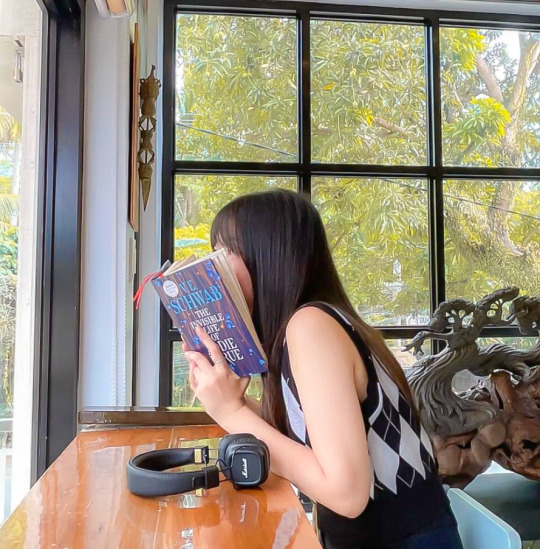
KEY EXPERIENCES
“Summer Time: A Book A Day”
Only after a few years of falling in love with the short stories, she managed to read over 7 books a week during her summer vacations. Although some readings are motivated by school credits, she still read an impressive amount during that time. She noted that she has read over 200 books since then. As life goes by, people get busy with their time. Even if life gets busy, she always tries to slip in a moment to read. She said “I read my book if I was waiting for something or if there’s a downtime—whether in public or at home. Because I do not have any cellular data on my phone when I leave the house, I always bring my book for times when I must wait.”
We asked her what was the first fiction she had read and she directed us back to her 3rd year of Junior High. She asked her classmate for a recommendation for a book to start reading fiction “She is also a bookwork and reads her book on an iPad. I asked her ‘What ‘s a good fiction to read first?’ and she let me borrow a copy of ‘The Little Prince’”. She noted that before that, she was not reading much then. After picking up the book, that is when she started being a book fanatic again.
On average, outside of summer time when she finishes a book a day, her average reading time then lasts for two to 3 days per novel. Now, she slowed down to finishing a book in a week but if she has work, then she finishes a book in a month. After she finishes a book, she takes a day to take a break and she picks up another book to start.
I’ll See It Through, Always
When she reads a book, she sees through it, even if it is average “It’s like in the movies, for example. I watch a movie and I find myself enjoying it but when I see some bad reviews, I don’t find it as a waste of time because I enjoyed the work”. She also added how she also thinks about the effort the author took to finish their story. That’s why sometimes when she finds a story in BookTok, a community in TikTok that shares content about literature, she reads it because of how it was marketed. Sometimes, she ends up reading erotic fiction without realizing it because of how the synopsis was advertised. During the interview, she laughingly said that she found that it was her guilty pleasure to read those types of stories
INSIGHTS
Eenie-Meenie-Miney Book!
When entering a bookstore, some people may feel overwhelmed when offered a lot of options. Jelaine is one of these individuals. Because of this, she has devised three ways to choose the next book she will indulge herself in. One is looking at its cover. As ironic as it is for a bibliophile, she does not really follow the famous saying “Don’t judge a book by its cover." When she sees that a book has an aesthetic and eye-catching cover, she will pick it up and read it. Though on some occasions, she will go through the book’s synopsis before buying it.
Another way is through recommendations in social media’s “BookTok". She follows countless book lovers on Instagram that post their recommendations in their feeds. When she sees these posts, she will buy two to three of those novels and put them on her shelf of books she will later read. Lastly, she picks up and buys the next novel that she will read by browsing the books of the same authors as the previously finished novel she enjoyed. With these three ways, she has fortunately bought novels that she considered a “good book".
"A Good Book"
It is fair to think that a bookworm that has read hundreds of novels would have a grasp of what makes a "good book". In Jelaine’s viewpoint, a novel that has a striking and grand plot is not important, but what is important is the story’s overall flow. She also added that “ A good book is something you can genuinely relate to the character even though that character has a different experience compared to you." Jelaine also mentioned that when she underlined and bookmarked a lot of lines and parts of a book that she is reading, then that novel is exceptional for her.

LESSONS TO SHARE
A Wider Vocabulary And Getting In Touch To One’s Feelings And Emotions
For almost half of her lifetime, Jelaine has been “sticking her nose" into numerous books in various genres and lengths. With all these consumed fictional works, she has gained extensive knowledge in vocabulary. She quoted, “Due to reading, my word bank is overflowing". As a result, she can understand words in novels that are unusual while also understanding each sentence that she reads quickly.
Reading has also helped her to become more empathetic, since she is able to know and feel what the characters are going through and understand them as the story goes on. Hence, when a person reads, they can be in touch with their emotions and process them in a healthy manner.
Something for Readers
Jelaine’s go-to book recommendation to whoever asks her is Celeste Ng’s first novel, "Everything I Never Told You". She deemed this as a good recommendation since it has themes that will make a person feel multiple emotions throughout its entirety. As she shares what the book is about, she mentions that it circles around the idea of family dynamics and how grief affects each member. She said, "This novel is heavy and heart-wrenching". Another book recommendation she mentioned was "Eleanor Oliphant is Completely Fine" written by Gail Honeyman, which is also a heavily emotional novel.
In addition, she mentioned a quote from one of the books that genuinely made an impact on her. The line was “They teach you growing up that you are only one thing at a time-angry, lonely, content--but he's never found that to be true. He is a dozen things at once. He is lost and scared and grateful, he is sorry and happy and afraid. But he is not alone.” This is from V. E. Schwab’s, "The Invisible Life Of Addie Larue. With these few pieces of line, she feels comforted and loved since it tells the reader that it is good to feel emotion and not to invalidate one’s feelings.
“When you read, it’s not just printed words on a paper, it is a mixture of the character’s experiences, feelings and views and in turn, you also experience what they have gone through and feel their emotions. With reading, you gain new experiences without physically experiencing them, but through words on a piece of paper." - Jelaine Dio
#booktok#bookworm#biblophile#literature#book recommendations#contemporary literatures#novels#fictional novels#cotemporary books
6 notes
·
View notes
Text
Fiction vs Nonfiction: Definitions & Comparisons

Both readers and authors need to be aware of the distinctions between fiction and nonfiction. These two overarching literary genres have different functions and affect our interactions with information and tales.
Understanding the differences between these genres can improve your reading experience and direct your writing efforts, whether you’re writing for readers interested in factual insights or diving into a fanciful realm.
What is Fiction?
Fiction refers to literary works that are created from the imagination rather than based on real events. This genre encompasses novels, short stories, and novellas that feature made-up characters, settings, and plots.
Characteristics of Fiction:
Imaginary Content: One of the main things that distinguishes fiction from nonfiction is its imaginative quality. Fiction authors create imaginary worlds, people, and events with the intention of amusing, stimulating the imagination, or exploring possible outcomes.
This imaginative component enables imaginative storytelling and a variety of plot twists that are not limited to following historical accuracy.
Writers can enthrall readers and provide them with a distinctive getaway from reality by creating captivating and imaginary components....Continue reading
#book writing#publishing#writing#book publication#book writer#book authors#book#book publishing#self publishing#literature#book publish#self publish#fiction#nonfiction#literacy#fiction books#fictional novels#self publishing platform#self publishing houses#book publishing platform#book publishing houses
0 notes
Text
I just think people write out of obligation too often.
"How do I motivate myself to write through the boring part of my story?"
"How do I make this boring scene not boring?"
Don't write it.
Don't write boring things just because you think the structure of the story demands it. I promise it doesn't need to be there.
If your characters need to have gone shopping for a later part of the story to make sense you can just have a sentence about how they went shopping and move on.
You are not obligated to write the boring parts. No matter what those parts are.
You are not obligated to make the parts of your story that you're not excited to write interesting somehow.
You can just write the fun and interesting parts and gloss over and summarize boring things.
Your audience will thank you and you will thank yourself.
#on writing#writing#writeblr#writblr#writing advice#fanfiction#fan fiction#fanfic#archive of our own#ao3#creative writing#creativity#novel writing
10K notes
·
View notes
Text
Dear diary,
I never read Anna Karenina... tragic I know but I've watched the film and I felt for her. I saw the book today in a bookstore and skimmed through it, I thought it would end with her throwing herself in front of a train but no. While the movie ends it there the novel goes on to tell of the lives of the other characters involved with her. Did you know there was a child, a girl the daughter of Anne that after death was taken in and raised as agreement by a man who wasn't her biological father? Did you know that it is said the lover grieved more deeply over her death than her husband. That she was talked about as being a bad woman for what she did in claims of wanting to be original.~
The author doesn't presume to tell us right or wrong he simply illustrates the events that occur leaving you to ponder meanings.~
I think it must be an extremely cruel fate to not only indure ridicule and scorn from society during life but even in death to have it be said about you.~
I feel sorry for Anne in that regard, why is it that so many women are looked as being something else than what should be by others, Anne K, Anne Boylan, Marie Antoinette. These women, if you call them that for they were girls that did their best in the society's in which they lived are judged so harshly.~
Do you have any idea what it must have been like to be regarded for your beauty as your main asset to a better life? The ultimate sign of success to marry a man who was a wealthy or with a good reputation etc.~
No one tells how to deal with the loneliness nor the longing for adventure that everyday life didn't offer in that regard.~
Maybe I romanticize too much, maybe I can't help wanting to save the lost girls because I am lost too.~
#dear diary#diary#diary entry#romanticizing#fictional characters#fictional musings#fictional novels#historical fiction#historic romantic fiction#fictional romance#fictional romance novels#love and romance#books#novels#classics#literature#literature and poetry#literature and art#literature and books#books and reading#library#book and reading#books and libraries#bookstore#bookstores and reading#cozycore#cozy bookstores#women in history#Victorian era#random thoughts
1 note
·
View note
Text

#fanfiction#writeblr#writer#writers#writing#writerscommunity#writblr#writer problems#writings#my writing#wip#write#being a writer#creative writing#female writers#fiction writing#just writer things#novel writing#writer life#writer meme#writer memes#writer struggles#writer stuff#writer things#writerblr#writers block#writers community#writers life#writers of tumblr#writers on tumblr
23K notes
·
View notes
Text
I think one of the weirdest side effects of being a writer is that while I'm reading, I'll just start subconsciously editing the book. Like, if a sentence sounds odd or off to me, I'll fix it in my head and continue reading as if that were how it was written.
Does anybody else do this?
#book writing#fiction writing#story writing#writeblr#creative writing#novel writing#writers#writing#am writing#aspiring writer#fantasy writer#original writing#teen writer#tumblr writers#tumblr writing community#writer#writer community#writer life#writer stuff#writer things#writerblr#writers and readers#writers community#writers life#writers of tumblr#writerscommunity#writers on tumblr#writerscorner#writing community#writing life
5K notes
·
View notes
Text
How to avoid White Room Syndrome
by Writerthreads on Instagram
A common problem writers face is "white room syndrome"—when scenes feel like they’re happening in an empty white room. To avoid this, it's important to describe settings in a way that makes them feel real and alive, without overloading readers with too much detail. Here are a few tips below to help!
Focus on a few key details
You don’t need to describe everything in the scene—just pick a couple of specific, memorable details to bring the setting to life. Maybe it’s the creaky floorboards in an old house, the musty smell of a forgotten attic, or the soft hum of a refrigerator in a small kitchen. These little details help anchor the scene and give readers something to picture, without dragging the action with heaps of descriptions.
Engage the senses
Instead of just focusing on what characters can see, try to incorporate all five senses—what do they hear, smell, feel, or even taste? Describe the smell of fresh bread from a nearby bakery, or the damp chill of a foggy morning. This adds a lot of depth and make the location feel more real and imaginable.
Mix descriptions with actions
Have characters interact with the environment. How do your characters move through the space? Are they brushing their hands over a dusty bookshelf, shuffling through fallen leaves, or squeezing through a crowded subway car? Instead of dumping a paragraph of description, mix it in with the action or dialogue.
Use the setting to reflect a mood or theme
Sometimes, the setting can do more than just provide a backdrop—it can reinforce the mood of a scene or even reflect a theme in the story. A stormy night might enhance tension, while a warm, sunny day might highlight a moment of peace. The environment can add an extra layer to what’s happening symbolically.
Here's an example of writing a description that hopefully feels alive and realistic, without dragging the action:
The bookstore was tucked between two brick buildings, its faded sign creaking with every gust of wind. Inside, the air was thick with the scent of worn paper and dust, mingling with the faint aroma of freshly brewed coffee from a corner café down the street. The wooden floorboards groaned as Ella wandered between the shelves, her fingertips brushing the spines of forgotten novels. Somewhere in the back, the soft sound of jazz crackled from an ancient radio.
Hope these tips help in your writing!
#writing#writing inspiration#writing tips#writers on tumblr#writing advice#creative writing#teen writer#writers block#writeblr#writers#on writing#writer#writerscommunity#writers of tumblr#writing community#novel writing#book writing#fiction
4K notes
·
View notes
Text

#it me#hmmm daydreaming go brrr#writing#fiction#creative writing#author#writerblr#writing community#my writing#writer#writers of tumblr#indie author#writing memes#novel writing#am writing#fantasy writing#book writing#fiction writing#story writing#writing blog#writing fiction#writing inspiration#writing meme
11K notes
·
View notes
Text
10 Ways to Add Sizzle to Your Boring Writing
Writing that sizzles captures the reader's attention and keeps them engaged from start to finish. Whether you're an experienced writer or just starting out, there are several techniques you can use to make your writing more exciting and dynamic. Here are ten detailed ways to add sizzle to your boring writing:
1. Use Vivid Descriptions
Vivid descriptions bring your writing to life by creating a rich, immersive experience for the reader. Instead of relying on generic or bland language, use specific details that appeal to the senses. Describe how things look, sound, smell, taste, and feel to paint a vivid picture.
In Detail:
Visual Descriptions: Use color, shape, and size to create a mental image. Instead of saying "The car was old," say "The rusty, olive-green car wheezed as it pulled into the driveway."
Sound Descriptions: Incorporate onomatopoeia and detailed sound descriptions. Instead of "The music was loud," say "The bass thumped, and the high notes pierced through the night air."
Smell and Taste Descriptions: Use sensory language. Instead of "The food was good," say "The aroma of roasted garlic and herbs filled the room, and the first bite was a burst of savory flavors."
2. Show, Don't Tell
"Show, don't tell" is a fundamental writing principle that means revealing information through actions, thoughts, dialogue, and sensory details rather than straightforward exposition. This approach makes your writing more engaging and allows readers to experience the story.
In Detail:
Actions Over Exposition: Instead of telling the reader "Jane was scared," show her fear through her actions: "Jane's hands trembled as she fumbled with the lock, her breath coming in shallow gasps."
Dialogue: Use conversations to reveal character traits and emotions. Instead of "John was angry," show his anger through his words and tone: "John's voice was a low growl as he said, 'I can't believe you did this.'"
Internal Thoughts: Reveal characters' inner worlds. Instead of "Emma felt relieved," show her relief: "Emma let out a long breath she didn't realize she was holding and sank into the chair, a smile tugging at her lips."
3. Create Relatable Characters
Relatable characters are crucial for keeping readers invested in your story. Characters should have depth, including strengths, weaknesses, desires, and fears. When readers see aspects of themselves in your characters, they're more likely to care about their journeys.
In Detail:
Character Flaws: Give your characters realistic flaws. A perfect character can be boring and unrelatable. Show how these flaws impact their decisions and relationships.
Character Arcs: Ensure your characters grow and change throughout the story. A well-crafted character arc can turn a good story into a great one.
Background and Motivations: Provide backstories and motivations. Why does your character act the way they do? What drives them? This adds depth and makes them more three-dimensional.
4. Add Dialogue
Dialogue can break up large blocks of text and make your writing more dynamic. It reveals character, advances the plot, and provides opportunities for conflict and resolution. Ensure your dialogue sounds natural and serves a purpose.
In Detail:
Natural Speech: Write dialogue that sounds like real conversation, complete with interruptions, pauses, and colloquial language. Avoid overly formal or stilted speech.
Purposeful Dialogue: Every line of dialogue should have a purpose, whether it's revealing character, advancing the plot, or building tension. Avoid filler conversations that don't add to the story.
Subtext: Use subtext to add depth. Characters might say one thing but mean another, revealing their true feelings through what they don't say directly.
5. Use Strong Verbs
Strong verbs make your writing more vivid and energetic. They convey action and emotion effectively, making your sentences more powerful and engaging.
In Detail:
Action Verbs: Choose verbs that show precise actions. Instead of "She went to the store," say "She dashed to the store."
Avoid Weak Verbs: Replace weak verbs and verb phrases with stronger alternatives. Instead of "He was walking," say "He strode."
Emotionally Charged Verbs: Use verbs that convey specific emotions. Instead of "She was sad," say "She wept."
6. Vary Sentence Structure
Varying sentence structure keeps your writing interesting and prevents it from becoming monotonous. Mix short, punchy sentences with longer, more complex ones to create a rhythm that engages readers.
In Detail:
Short Sentences for Impact: Use short sentences to create tension, urgency, or emphasize a point. "He stopped. Listened. Nothing."
Complex Sentences for Detail: Use longer sentences to provide detailed descriptions or explain complex ideas. "As the sun set behind the mountains, the sky transformed into a canvas of oranges, pinks, and purples, casting a warm glow over the serene landscape."
Combine Different Structures: Mix simple, compound, and complex sentences to maintain a natural flow. Avoid repetitive patterns that can make your writing feel flat.
7. Introduce Conflict
Conflict is the driving force of any story. It creates tension and keeps readers invested in the outcome. Without conflict, your story can become stagnant and uninteresting.
In Detail:
Internal Conflict: Characters should struggle with internal dilemmas, fears, and desires. This adds depth and relatability.
External Conflict: Introduce obstacles and challenges that characters must overcome. This can be other characters, societal pressures, or natural forces.
Resolution: Show how conflicts are resolved, leading to character growth and plot progression. Ensure resolutions feel earned and satisfying.
8. Use Metaphors and Similes
Metaphors and similes add creativity and depth to your writing. They help readers understand complex ideas and emotions by comparing them to familiar experiences.
In Detail:
Metaphors: Directly state that one thing is another to highlight similarities. "Time is a thief."
Similes: Use "like" or "as" to make comparisons. "Her smile was like sunshine on a rainy day."
Avoid Clichés: Create original comparisons rather than relying on overused phrases. Instead of "busy as a bee," find a fresh analogy.
9. Create Suspense
Suspense keeps readers on the edge of their seats, eager to find out what happens next. Use foreshadowing, cliffhangers, and unanswered questions to build tension and anticipation.
In Detail:
Foreshadowing: Drop subtle hints about future events. This creates anticipation and a sense of inevitability.
Cliffhangers: End chapters or sections with unresolved tension or unanswered questions to compel readers to keep going.
Pacing: Control the pace of your story to build suspense. Slow down for crucial moments and speed up during action scenes.
10. Edit Ruthlessly
Great writing often emerges during the editing process. Be willing to cut unnecessary words, tighten your prose, and refine your sentences. Editing improves clarity, pace, and overall readability.
In Detail:
Cut Redundancies: Remove unnecessary words and repetitive phrases. "In my opinion, I think" can be reduced to "I think."
Focus on Clarity: Ensure each sentence conveys its intended meaning clearly and concisely.
Proofread: Check for grammar, punctuation, and spelling errors. A polished manuscript reflects professionalism and attention to detail.
#writeblr#writing#creative writing#thewriteadviceforwriters#writing tips#writers block#on writing#writers and poets#how to write#novel writing#writing blog#writing advice#writer#authoradvice#author#book writing#women writers#fiction#authors on tumblr#novelist#writer stuff#female writers#fiction writing#fantasy novel#novel
5K notes
·
View notes
Text
Contemporary Japanese light novels and classic American sci-fi are basically evil opposites when it comes to their titling conventions: both titles will be long and rambling, but the former will be a prosaically descriptive phrase that lays out the story's entire premise, while the latter will be a line from a poem the author liked that tells you absolutely fucking nothing.
10K notes
·
View notes
Text
Writing rule:
Every character who speaks gets their own paragraph. If two characters are talking, each time they switch you must create a new paragraph.
Do not add more than one characters’s dialogue into a single paragraph or it will be too confusing for the reader.
#writing advice#writing tips#author advice#author tips#writing#writeblr#authors#books#writblr#author#aspiring writer#fiction writing#novel writing#creative writing#authors supporting authors#author blog#writing blog#stories#writerscorner#writing help#writing rules#wattpad author#ao3#wattpad#ao3 writer#wattpad writer#writer blog
6K notes
·
View notes
Text
☀️ What I'd give for just a few more days with you… 💀
The Kickstarter for the new A Date with Death DLC is live NOW!
Help us fund five extra days, new art, new endings, and more… and pick up some cool rewards along the way!
Support us here:
#a date with death#otome#kickstarter#indie game#two and a half studios#gamedev#visual novel#vn#interactive fiction
2K notes
·
View notes
Text
ngl, I'm beginning to take issue with how in conversations about anti-intellectualism almost automatically, the face of girls and women will be slapped on the problem.
#'all those tiktok girls who only like marvel films and' - why do you always say girls and women? are the guys filling opera halls instead?#'women in their mid 20s who still only read YA novels' okay sure that's an example and relevant discussions can be had#but it reminds me of the mocking tone in which people speak of 'chick-lit' to use women's interest as an indicator of lower value#while in fact women are reading more than men in EVERY single genre of fiction. Women are doing a lot of (often unpaid) labour#supporting libaries supporting theatres supporting cultural events#meanwhile there is a pretty big overlap between toxic masculinity and anti-intellectualism#(especially misogyny and homophobia)#especially when it comes to things like ballet or opera or musical or generally dance#in fact it is often the female investment in specific things that makes them less 'valuable' in general consciousness#for thousands of years the theatre was well-respected and a high form of art - and now it's a 'wife-thing'#the father who will teach his son that theatre and dance are for girls - how is that never an example for anti-intellectualism
17K notes
·
View notes
Text
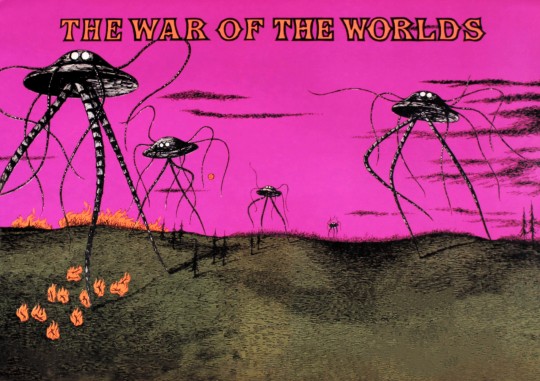








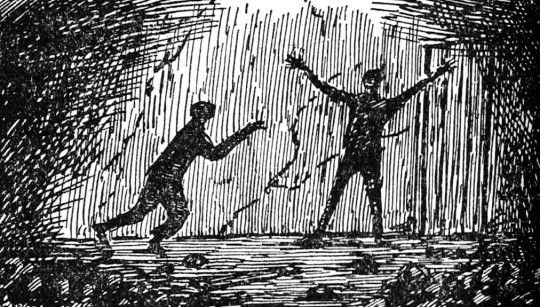

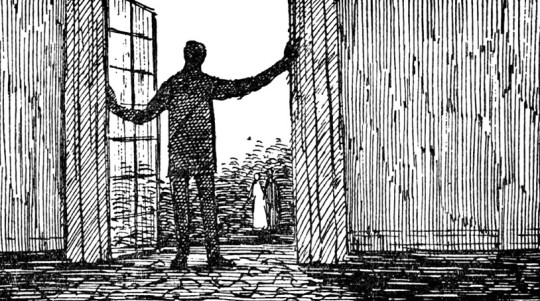









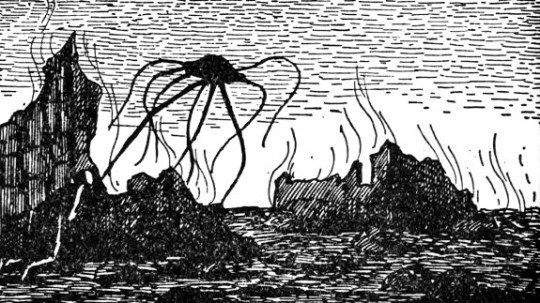




The War of the Worlds - art by Edward Gorey (1960)
#edward gorey#the war of the worlds#h. g. wells#book illustrations#60s sci-fi art#sci-fi novels#science-fiction#martians#1898#sixties#1960
4K notes
·
View notes
Text
Does anybody else ever get writing fatigue from your current WIP, so you just... start another one to refresh yourself?
Cause I just did.
Again.
I need help.
#book writing#fiction writing#story writing#writeblr#writers on tumblr#writerscommunity#writer struggles#writer stuff#writers life#am writing#writers of tumblr#writing#writing community#writing life#writing memes#writing problems#writing questions#writers#creative writing#novel writing
3K notes
·
View notes
Text
✦ LOST IN LIMBO — A DARK FANTASY ROMANCE VISUAL NOVEL KICKSTARTER IS NOW LIVE!
Lost in Limbo, our +17 dark fantasy romance visual novel, is now live on Kickstarter!
When you finally quit your dead-end job and move back to your mother's house in the ever-peaceful town of Faybourne, you think things could only get better. However, the moment you set foot in your childhood home, a harrowing nightmare long forgotten appears to haunt you once more.
A tower that crumbles in the vastness of a bleeding sky. A voice that mourns and yearns for something.
Torn away from your peaceful life and thrown into a world of danger and deceit, you are at the mercy of the Seven Sovereigns of Limbo. Navigate the Realm Between as it faces an impending cataclysm that threatens to swallow you and those you love whole.
As the consequences of a plan set in motion long ago start to unveil, will love be the key to your freedom, or the first chapter of your downfall?
We have some amazing stretch goals, like a Switch Port, two unlockable new routes, and +18 NSFW chapters! Please consider supporting us if you enjoyed our demo!
✦ PLAY OUR DEMO HERE:
STEAM
ITCHIO
GOOGLE PLAY

#lost in limbo#visual novel#otome#indiedev#interactive fiction#amare#oelvn#indie otome#kickstarter#dating sim
1K notes
·
View notes